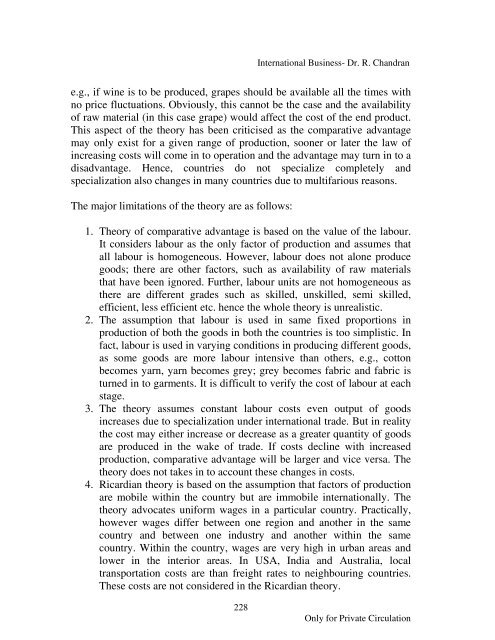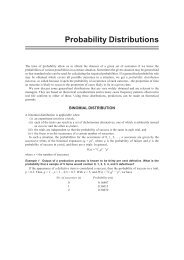International-Business-Dr-R-Chandran-E-book
International-Business-Dr-R-Chandran-E-book
International-Business-Dr-R-Chandran-E-book
Create successful ePaper yourself
Turn your PDF publications into a flip-book with our unique Google optimized e-Paper software.
228<br />
<strong>International</strong> <strong>Business</strong>- <strong>Dr</strong>. R. <strong>Chandran</strong><br />
e.g., if wine is to be produced, grapes should be available all the times with<br />
no price fluctuations. Obviously, this cannot be the case and the availability<br />
of raw material (in this case grape) would affect the cost of the end product.<br />
This aspect of the theory has been criticised as the comparative advantage<br />
may only exist for a given range of production, sooner or later the law of<br />
increasing costs will come in to operation and the advantage may turn in to a<br />
disadvantage. Hence, countries do not specialize completely and<br />
specialization also changes in many countries due to multifarious reasons.<br />
The major limitations of the theory are as follows:<br />
1. Theory of comparative advantage is based on the value of the labour.<br />
It considers labour as the only factor of production and assumes that<br />
all labour is homogeneous. However, labour does not alone produce<br />
goods; there are other factors, such as availability of raw materials<br />
that have been ignored. Further, labour units are not homogeneous as<br />
there are different grades such as skilled, unskilled, semi skilled,<br />
efficient, less efficient etc. hence the whole theory is unrealistic.<br />
2. The assumption that labour is used in same fixed proportions in<br />
production of both the goods in both the countries is too simplistic. In<br />
fact, labour is used in varying conditions in producing different goods,<br />
as some goods are more labour intensive than others, e.g., cotton<br />
becomes yarn, yarn becomes grey; grey becomes fabric and fabric is<br />
turned in to garments. It is difficult to verify the cost of labour at each<br />
stage.<br />
3. The theory assumes constant labour costs even output of goods<br />
increases due to specialization under international trade. But in reality<br />
the cost may either increase or decrease as a greater quantity of goods<br />
are produced in the wake of trade. If costs decline with increased<br />
production, comparative advantage will be larger and vice versa. The<br />
theory does not takes in to account these changes in costs.<br />
4. Ricardian theory is based on the assumption that factors of production<br />
are mobile within the country but are immobile internationally. The<br />
theory advocates uniform wages in a particular country. Practically,<br />
however wages differ between one region and another in the same<br />
country and between one industry and another within the same<br />
country. Within the country, wages are very high in urban areas and<br />
lower in the interior areas. In USA, India and Australia, local<br />
transportation costs are than freight rates to neighbouring countries.<br />
These costs are not considered in the Ricardian theory.<br />
Only for Private Circulation





